Exhibit review (part one) and a job posting
First, the job posting--since i've been such the gloom-monger about theatres closing in the news, i'd feel remiss if i didn't help propogate this *excellent* job opportunity. No less than four former colleagues have forwarded it to me, and to be honest, if i weren't planning to operate with the Triangle as my "home base" for at minimum five more years, i'd apply in a heartbeat.
Essentially, budgetary restructuring has resulted in a change-up at the Guthrie Theatre in Minneapolis, MN. They used to have a separate painter/dyer and crafts artisan/milliner--two jobs, two employees. Now though, they're combining those two positions into a single one. The Guthrie is a heavy-hitter in regional theatre, with it's brand-new (as of 2006) facility featuring three stages, on which they produce a range of productions from musicals to Shakespeare to new works and world premieres. They do between 7 and 13 shows a year, including an annual Christmas Carol and usually at least one touring show. Working there would mean a wide range of different works, with world-class designers, directors, and performers.
You can read the full job posting here, if you're interested. The job's through their local IATSE so figure on union benefits and payscale.
* * * * *
Last month, Peace College in Raleigh hosted the North Carolina 2009 Quilt Symposium, and--being a huge fan of all areas of fiber art, particularly quilts--I headed down there to check it out.
I think i'm especially drawn to the medium of quilting for the same reasons i'm drawn to the profession of crafts artisanship. Quilting comes from a rich panoply of histories, its techniques and styles couched in such a diversity of cultures, from the solid geometry of the Amish tradition, to the graphic strip-piecing of Gee's Bend, to the intricate complexity of Hawaiian applique. It's both an art and a craft, a blend of skill, inspiration, and practicality, and is usually the province of women artists. It can be improvisational or mathematical or both, and--like theatre--engenders collaboration and community.
Isn't the cooperative nature of a quilting bee, a round-robin, or a block-swap similar, conceptually, to a theatre production? Groups of artists come together to coordinate the production of quilts, to gather in guilds for inspiration and collaboration. At the Symposium, rarely did i see a work produced by only one pair of hands--most all involved at least two artists (one who pieced the top and another who quilted the layers), often more. And like theatre artists, quilt artists seem particularly drawn to participating actively in their communities through their work, holding benefit raffles for local charities or creating works for specific causes (such as making comfort quilts for hospitalized children or valor quilts for returning soldiers).
The Symposium was so extensive, I'm going to split the coverage into two posts, the first of which will be images of wearables, accessory design (there was a handbag competition and silent auction), and what they categorized in their competition breakdown as "Studio Art"--free-form wallhanging-scale works often featuring 3D elements or specialized techniques like photo-transfer. The second post (probably coming tomorrow) will focus on larger-scale works which often utilize traditional patterns or specific recognized styles of execution. Admittedly, i didn't come close to photographing the entire thing--there were hundreds of pieces on display. I didn't stick to "ribbon winners" or anything either; i took pictures based on the criteria of whether i felt inspired to respond to an artwork or some element struck me as worth documenting.
Peace College itself was a striking setting for the symposium--it's a beautiful historical liberal-arts women's college, an intimate campus of striking old architecture and classical gardens of shade trees and foliage in bloom.
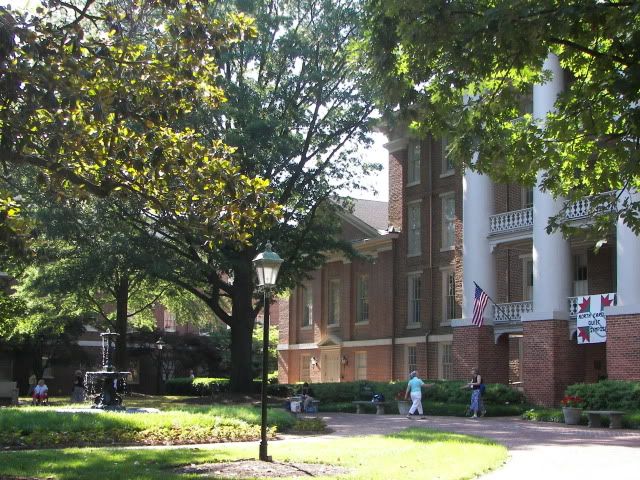
The courtyard at Peace College outside the Symposium buildings.
Hanging Artworks
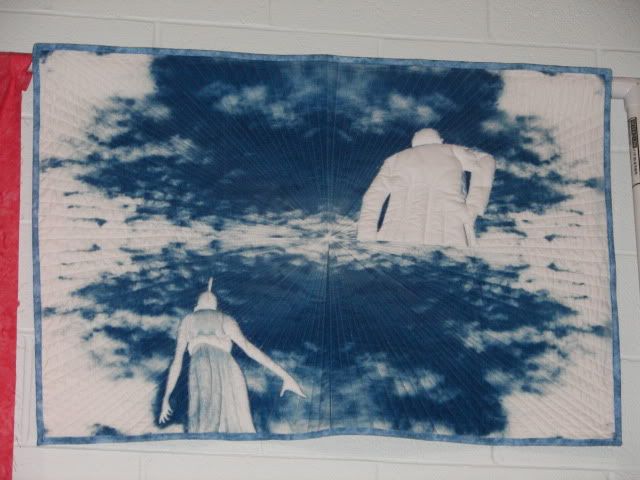
This indigo resist-dyed piece was unlabeled and not part of the competitions--it was displayed high on a wall in the vending area over a booth with hand-dyed fabrics for sale. I loved the composition of it, the ambiguity of the setting , and how the radial lines of quilting help add to the perception of depth in the scene.
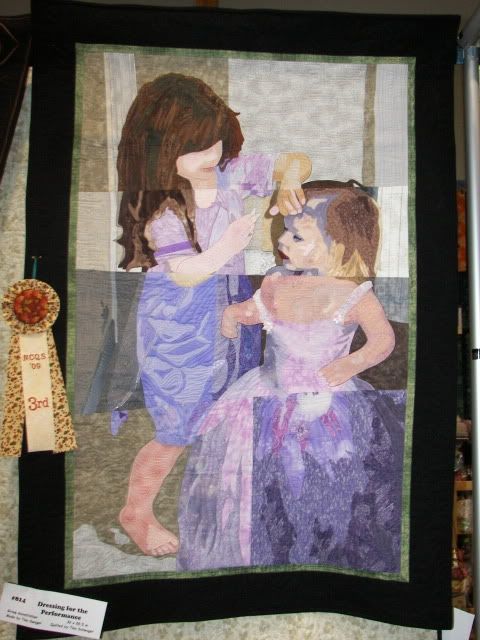
This piece, Dressing for the Performance (3rd Place, Group Quilt), is a "Piecemeal Bee" group quilt conceived and assembled by Tina Schwager. (A "piecemeal" quilt typically means that the quiltwright(s) utilized fabric scraps somewhat improvisationally, as opposed to following a set plan with new fabrics.) I gather that the design came from a computer-manipulated photograph, divided into stark blocks and "assigned" to the various participants in the construction. I love how this process resulted in the different value levels in the composition of the finished piece, due to the various families of fabrics each bee-member employed in the construction of her/his assigned area.
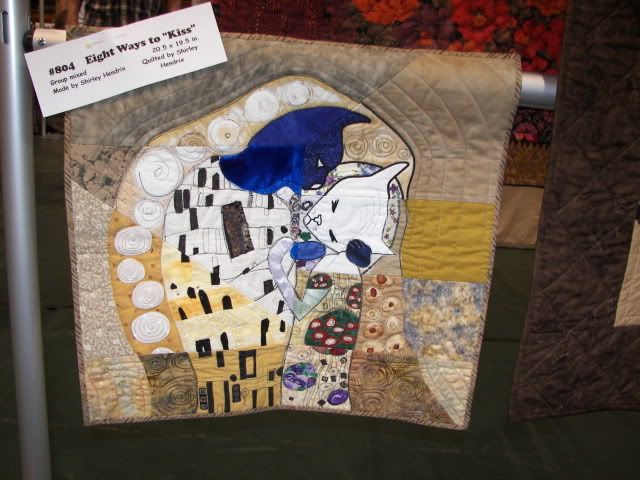
Eight Ways to "Kiss" is another Piecemeal Bee group quilt conceived and assembled by Shirley Hendrix. I can't decide if i find the bizarre introduction of cat-kitsch hung upon the framework of a Klimt painting to be revolting, hilarious, or both. I almost wish it had some kind of Lolcats slogan appliqued into the border, a la IM IN UR MUZEEUM SMOOCHIN YR FACE!!1, because then at least i'd be certain of my response. There's some interesting stuff going on technique-wise, and it's unusually cohesive, visually, for a piecemeal construction.
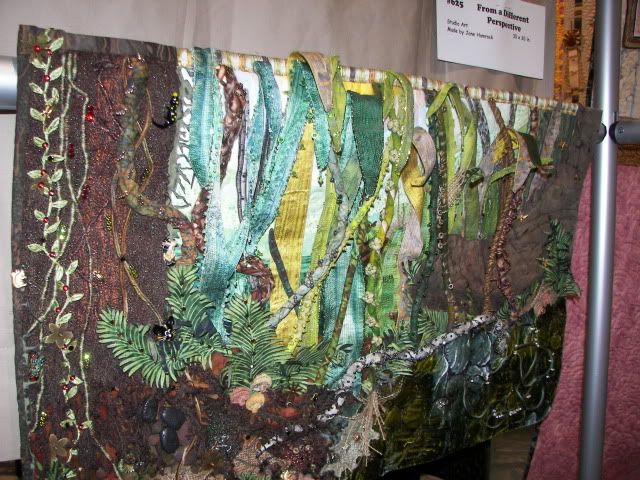
I hate that the lighting sucked for capturing this piece, From a Different Perspective by Jane Hamrock, and you have to look close to see just HOW three-dimensional it is. In addition to layering of dyed and printed fabrics interspersed with free-form thread-painting and beadwork, she incorporated fronds of silk plants and dyed cording sprouting out of the piece, which gave it a startling effect in-person.
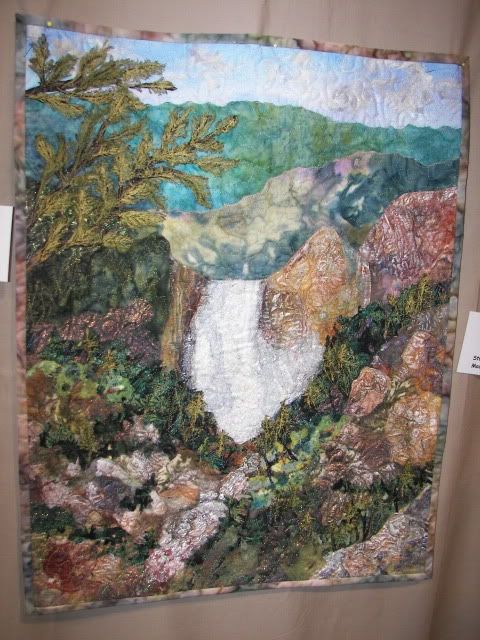
Yellowstone Falls by Annette Rogers is another 3D studio-art quilt. I particularly love the use of mottled hand-dyed fabrics to create the various aspects of the landscape--stones, bald mountains, vegetation, and the sliver of sky. Rogers, like Hamrock, incorporated some fabric fronds for dimensional plant effects, too.
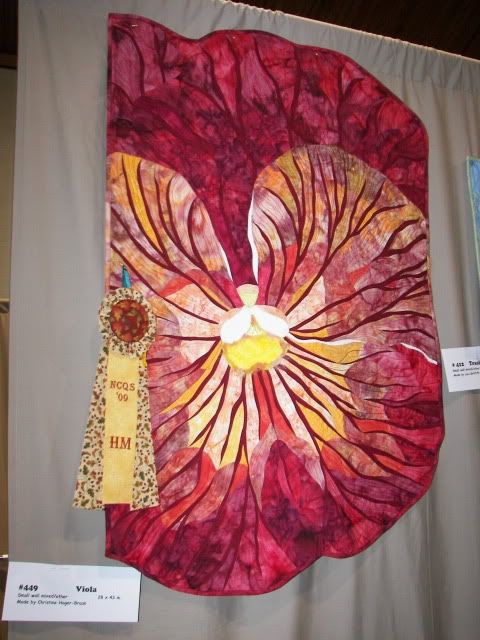
Viola by Christine Hager-Braun (Honorable Mention, Small Wall Hanging) reminded me of an O'Keeffe painting in how the pansy blossom is the total focus of the piece, at a scale where it even supercedes the boundaries of the work itself.
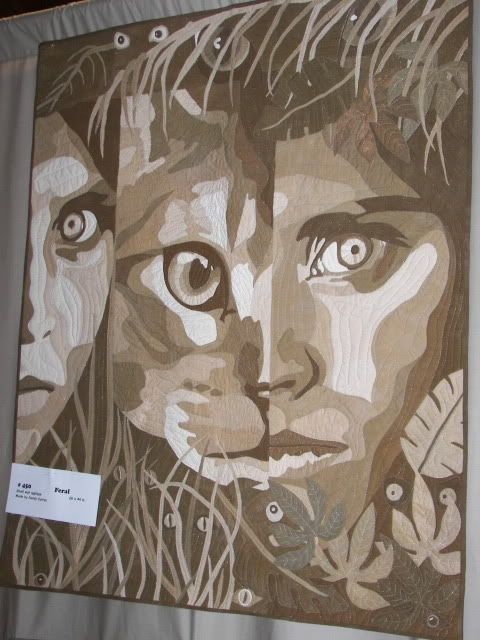
Feral by Sandy Curran didn't strike me at first, but the more i looked at it, the more interested i became in what was going on--the spliced human and feline portraiture, the choice of a sepia-tone color palette (perhaps a nod to nocturnal vision), and the multitude of eyes hiding in the backgrounds of each section.
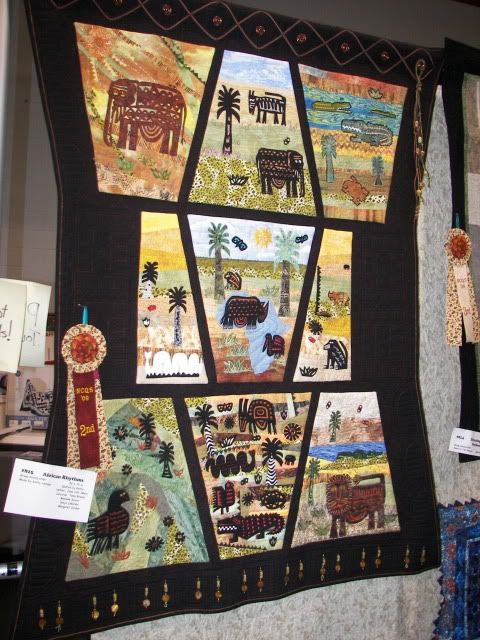
African Rhythms, 2nd Place in Group Quilts, was conceived and assembled by Kathy Hefner, and quilted by Kathy Hefner, Jane Hall, Mary Corcoran, Tama Brooks, Marlene Royce, Sonja LeBorde, and Margaret Jordan. A piece of African fabric with animal motifs was the common inspiration, and Hefner used the shape of a drum to formulate the irregular block layout.
Wearable Artworks and Bags
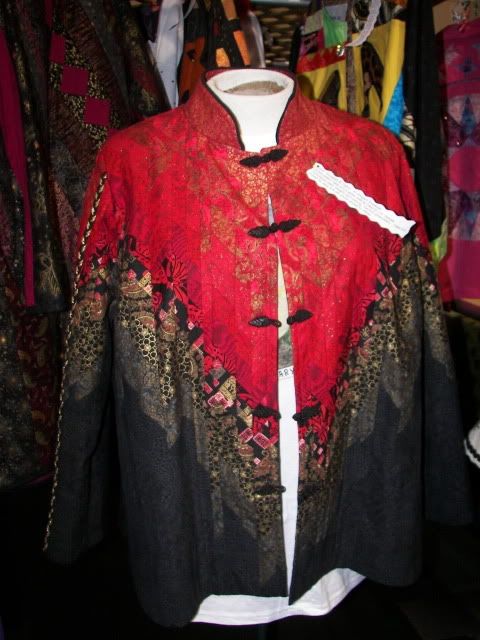
Elizabeth B. Dalton's bargello-pieced jacket, An Elegant Envelope, was one of the wearables displayed on a dress form. Much to my chagrin, they only had four forms for showing wearables and the remainder were hung on a couple of clothes racks. Sometimes there were white-gloved attendants willing to take down pieces by request and show you the interiors or details, but for the most part, the whole setup was disappointing and hard to view.
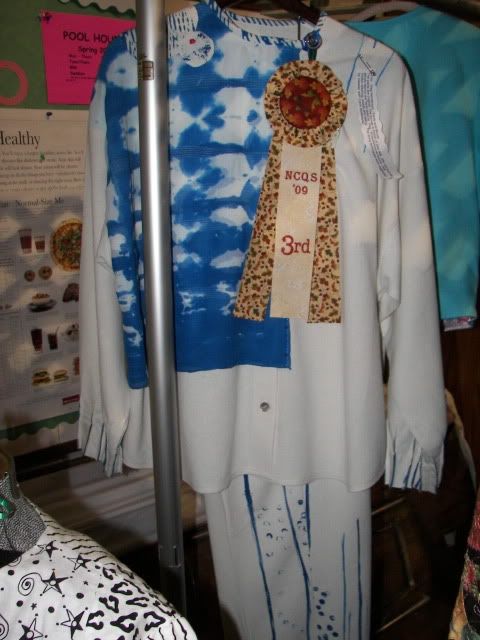
See what i mean? This intricately patterned, shibori-dyed silk noil ensemble by Peg Henderson (sensibly entitled Pants and Blouse) was stuck back in the back on a rack, despite its having won 3rd Place in Wearables. Too bad, because i'd have loved to see it better.
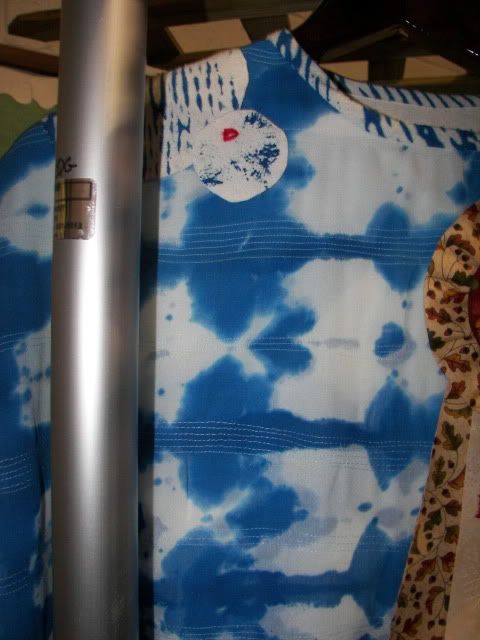
Here i did get a bit of detail on the dyeing/stitching of one section.
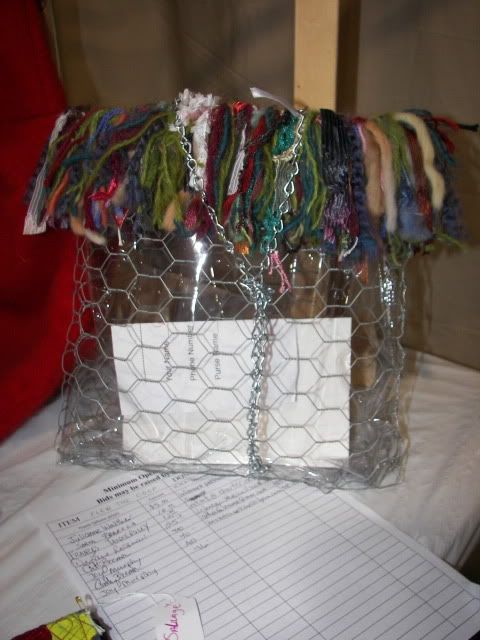
Weirdly, the Symposium catalog doesn't list the purse artists, so I don't have a name for this work's creator. I loved how s/he used chicken wire sandwiched in heavy polyurethane for the body of the bag, and the variety of textures employed in the fringed opening of fancy yarns and feathers.
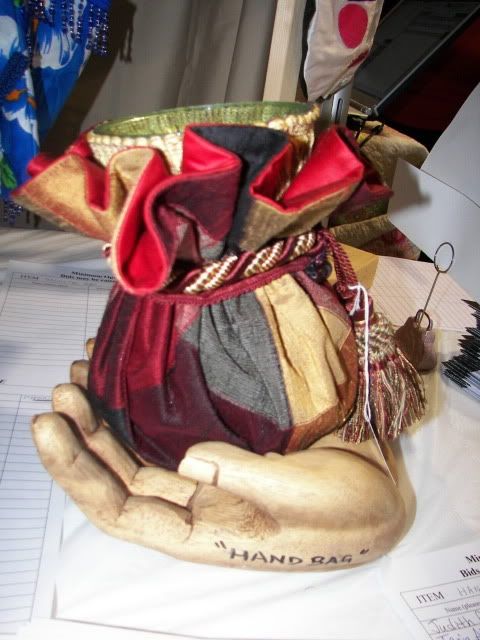
This one was my absolute favorite of the bags, though. Not only is the carved wooden hand a part of the bag, but the fabric is cinched around an interior glass bulb-shaped vase (you can see a bit of the flare of the opening in the photo).
To be continued...perhaps tomorrow!
Essentially, budgetary restructuring has resulted in a change-up at the Guthrie Theatre in Minneapolis, MN. They used to have a separate painter/dyer and crafts artisan/milliner--two jobs, two employees. Now though, they're combining those two positions into a single one. The Guthrie is a heavy-hitter in regional theatre, with it's brand-new (as of 2006) facility featuring three stages, on which they produce a range of productions from musicals to Shakespeare to new works and world premieres. They do between 7 and 13 shows a year, including an annual Christmas Carol and usually at least one touring show. Working there would mean a wide range of different works, with world-class designers, directors, and performers.
You can read the full job posting here, if you're interested. The job's through their local IATSE so figure on union benefits and payscale.
* * * * *
Last month, Peace College in Raleigh hosted the North Carolina 2009 Quilt Symposium, and--being a huge fan of all areas of fiber art, particularly quilts--I headed down there to check it out.
I think i'm especially drawn to the medium of quilting for the same reasons i'm drawn to the profession of crafts artisanship. Quilting comes from a rich panoply of histories, its techniques and styles couched in such a diversity of cultures, from the solid geometry of the Amish tradition, to the graphic strip-piecing of Gee's Bend, to the intricate complexity of Hawaiian applique. It's both an art and a craft, a blend of skill, inspiration, and practicality, and is usually the province of women artists. It can be improvisational or mathematical or both, and--like theatre--engenders collaboration and community.
Isn't the cooperative nature of a quilting bee, a round-robin, or a block-swap similar, conceptually, to a theatre production? Groups of artists come together to coordinate the production of quilts, to gather in guilds for inspiration and collaboration. At the Symposium, rarely did i see a work produced by only one pair of hands--most all involved at least two artists (one who pieced the top and another who quilted the layers), often more. And like theatre artists, quilt artists seem particularly drawn to participating actively in their communities through their work, holding benefit raffles for local charities or creating works for specific causes (such as making comfort quilts for hospitalized children or valor quilts for returning soldiers).
The Symposium was so extensive, I'm going to split the coverage into two posts, the first of which will be images of wearables, accessory design (there was a handbag competition and silent auction), and what they categorized in their competition breakdown as "Studio Art"--free-form wallhanging-scale works often featuring 3D elements or specialized techniques like photo-transfer. The second post (probably coming tomorrow) will focus on larger-scale works which often utilize traditional patterns or specific recognized styles of execution. Admittedly, i didn't come close to photographing the entire thing--there were hundreds of pieces on display. I didn't stick to "ribbon winners" or anything either; i took pictures based on the criteria of whether i felt inspired to respond to an artwork or some element struck me as worth documenting.
Peace College itself was a striking setting for the symposium--it's a beautiful historical liberal-arts women's college, an intimate campus of striking old architecture and classical gardens of shade trees and foliage in bloom.

The courtyard at Peace College outside the Symposium buildings.
Hanging Artworks

This indigo resist-dyed piece was unlabeled and not part of the competitions--it was displayed high on a wall in the vending area over a booth with hand-dyed fabrics for sale. I loved the composition of it, the ambiguity of the setting , and how the radial lines of quilting help add to the perception of depth in the scene.

This piece, Dressing for the Performance (3rd Place, Group Quilt), is a "Piecemeal Bee" group quilt conceived and assembled by Tina Schwager. (A "piecemeal" quilt typically means that the quiltwright(s) utilized fabric scraps somewhat improvisationally, as opposed to following a set plan with new fabrics.) I gather that the design came from a computer-manipulated photograph, divided into stark blocks and "assigned" to the various participants in the construction. I love how this process resulted in the different value levels in the composition of the finished piece, due to the various families of fabrics each bee-member employed in the construction of her/his assigned area.

Eight Ways to "Kiss" is another Piecemeal Bee group quilt conceived and assembled by Shirley Hendrix. I can't decide if i find the bizarre introduction of cat-kitsch hung upon the framework of a Klimt painting to be revolting, hilarious, or both. I almost wish it had some kind of Lolcats slogan appliqued into the border, a la IM IN UR MUZEEUM SMOOCHIN YR FACE!!1, because then at least i'd be certain of my response. There's some interesting stuff going on technique-wise, and it's unusually cohesive, visually, for a piecemeal construction.

I hate that the lighting sucked for capturing this piece, From a Different Perspective by Jane Hamrock, and you have to look close to see just HOW three-dimensional it is. In addition to layering of dyed and printed fabrics interspersed with free-form thread-painting and beadwork, she incorporated fronds of silk plants and dyed cording sprouting out of the piece, which gave it a startling effect in-person.

Yellowstone Falls by Annette Rogers is another 3D studio-art quilt. I particularly love the use of mottled hand-dyed fabrics to create the various aspects of the landscape--stones, bald mountains, vegetation, and the sliver of sky. Rogers, like Hamrock, incorporated some fabric fronds for dimensional plant effects, too.

Viola by Christine Hager-Braun (Honorable Mention, Small Wall Hanging) reminded me of an O'Keeffe painting in how the pansy blossom is the total focus of the piece, at a scale where it even supercedes the boundaries of the work itself.

Feral by Sandy Curran didn't strike me at first, but the more i looked at it, the more interested i became in what was going on--the spliced human and feline portraiture, the choice of a sepia-tone color palette (perhaps a nod to nocturnal vision), and the multitude of eyes hiding in the backgrounds of each section.

African Rhythms, 2nd Place in Group Quilts, was conceived and assembled by Kathy Hefner, and quilted by Kathy Hefner, Jane Hall, Mary Corcoran, Tama Brooks, Marlene Royce, Sonja LeBorde, and Margaret Jordan. A piece of African fabric with animal motifs was the common inspiration, and Hefner used the shape of a drum to formulate the irregular block layout.
Wearable Artworks and Bags

Elizabeth B. Dalton's bargello-pieced jacket, An Elegant Envelope, was one of the wearables displayed on a dress form. Much to my chagrin, they only had four forms for showing wearables and the remainder were hung on a couple of clothes racks. Sometimes there were white-gloved attendants willing to take down pieces by request and show you the interiors or details, but for the most part, the whole setup was disappointing and hard to view.

See what i mean? This intricately patterned, shibori-dyed silk noil ensemble by Peg Henderson (sensibly entitled Pants and Blouse) was stuck back in the back on a rack, despite its having won 3rd Place in Wearables. Too bad, because i'd have loved to see it better.

Here i did get a bit of detail on the dyeing/stitching of one section.

Weirdly, the Symposium catalog doesn't list the purse artists, so I don't have a name for this work's creator. I loved how s/he used chicken wire sandwiched in heavy polyurethane for the body of the bag, and the variety of textures employed in the fringed opening of fancy yarns and feathers.

This one was my absolute favorite of the bags, though. Not only is the carved wooden hand a part of the bag, but the fabric is cinched around an interior glass bulb-shaped vase (you can see a bit of the flare of the opening in the photo).
To be continued...perhaps tomorrow!